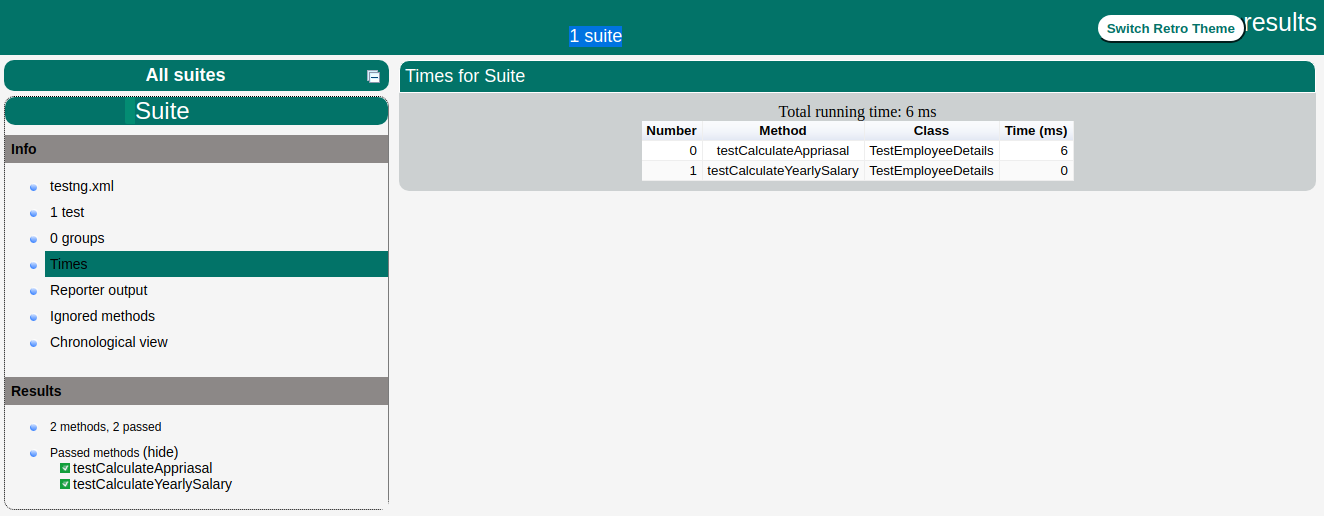Writing a test in TestNG basically involves the following steps:
Create EmployeeDetails.java in C:\>TestNG_WORKSPACE, which is a POJO class.

- Write the business logic of your test and insert TestNG annotations in your code.
- Add the information about your test (e.g. the class name, the groups you wish to run, etc.) in a testng.xml file or in build.xml.
- Run TestNG.
Create EmployeeDetails.java in C:\>TestNG_WORKSPACE, which is a POJO class.
public class EmployeeDetails { private String name; private double monthlySalary; private int age; // @return the name public String getName() { return name; } // @param name the name to set public void setName(String name) { this.name = name; } // @return the monthlySalary public double getMonthlySalary() { return monthlySalary; } // @param monthlySalary the monthlySalary to set public void setMonthlySalary(double monthlySalary) { this.monthlySalary = monthlySalary; } // @return the age public int getAge() { return age; } // @param age the age to set public void setAge(int age) { this.age = age; } }EmployeeDetails class is used to.
- get/set the value of employee's name.
- get/set the value of employee's monthly salary.
- get/set the value of employee's age.
public class EmpBusinessLogic { // Calculate the yearly salary of employee public double calculateYearlySalary(EmployeeDetails employeeDetails){ double yearlySalary = 0; yearlySalary = employeeDetails.getMonthlySalary() * 12; return yearlySalary; } // Calculate the appraisal amount of employee public double calculateAppraisal(EmployeeDetails employeeDetails){ double appraisal = 0; if(employeeDetails.getMonthlySalary() < 10000){ appraisal = 500; }else{ appraisal = 1000; } return appraisal; } }EmpBusinessLogic class is used for calculating:
- the yearly salary of employee.
- the appraisal amount of employee.
import org.testng.Assert; import org.testng.annotations.Test; public class TestEmployeeDetails { EmpBusinessLogic empBusinessLogic = new EmpBusinessLogic(); EmployeeDetails employee = new EmployeeDetails(); @Test public void testCalculateAppriasal() { employee.setName("Rajeev"); employee.setAge(25); employee.setMonthlySalary(8000); double appraisal = empBusinessLogic.calculateAppraisal(employee); Assert.assertEquals(500, appraisal, 0.0, "500"); } // Test to check yearly salary @Test public void testCalculateYearlySalary() { employee.setName("Rajeev"); employee.setAge(25); employee.setMonthlySalary(8000); double salary = empBusinessLogic.calculateYearlySalary(employee); Assert.assertEquals(96000, salary, 0.0, "8000"); } }TestEmployeeDetails class is used for testing the methods of EmpBusinessLogic class. It does the following:
- Tests the yearly salary of the employee.
- Tests the appraisal amount of the employee.
<?xml version="1.0" encoding="UTF-8"?> <!DOCTYPE suite SYSTEM "http://testng.org/testng-1.0.dtd" > <suite name="Suite1"> <test name="test1"> <classes> <class name="TestEmployeeDetails"/> </classes> </test> </suite>Details of the above file are as follows:
- A suite is represented by one XML file. It can contain one or more tests and is defined by the <suite> tag.
- Tag <test> represents one test and can contain one or more TestNG classes.
- <class> tag represents a TestNG class. It is a Java class that contains at least one TestNG annotation. It can contain one or more test methods.
C:\TestNG_WORKSPACE>javac EmployeeDetails.java EmpBusinessLogic.java TestEmployeeDetails.javaNow TestNG with the following command:
C:\TestNG_WORKSPACE>java -cp "C:\TestNG_WORKSPACE" org.testng.TestNG testng.xmlIf all has been done correctly, you should see the results of your tests in the console. Furthermore, TestNG creates a very nice HTML report in a folder called test-output that is automatically created in the current directory. If you open it and load index.html, you will see a page similar to the one in the image below:


No comments:
Post a Comment